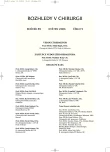Percutaneous Cholecystostomy in Acute Cholecystitis – A Solution for Risk Patient Groups?
Authors:
P. Horák 1; R. Pádr 2; J. Hoch 1
Authors‘ workplace:
Chirurgická klinika UK 2. LF a FN Motol, Praha, přednosta prof. MUDr. J. Hoch, CSc.
1; Klinika zobrazovacích metod UK 2. LF a FN Motol, Praha, přednosta prof. MUDr. J. Neuwirt, CSc.
2
Published in:
Rozhl. Chir., 2006, roč. 85, č. 5, s. 236-238.
Category:
Monothematic special - Original
Overview
In treating acute cholecystitis in patients with a high operative risk, the general rule is to treat conservatively, with surgery indicated in those patients where this therapy is insufficient. Cholecystotomy is one alternative method of treatment. Due to its disadvantages, it belongs to one of the most seldomly used surgical procedures. These drawbacks, however, may be curtailed by using a percutaneous cholecystotomy (PC) done under CT or US navigation. The authors here recount their experiences of treating acute cholecystitis with PC in two case studies, relating difficulties in indication, technical performance, and complications of the procedure. In accordance with scientific literature, we consider PC an effective treatment method with minimal complications.
Key words:
acute cholecystitis – high operative risk – percutaneous cholecystostomy
Labels
Surgery Orthopaedics Trauma surgeryArticle was published in
Perspectives in Surgery

2006 Issue 5
Most read in this issue
- Laparoscopic Rectopexis
- Tracheal Tumor – A Case Review
- Percutaneous Cholecystostomy in Acute Cholecystitis – A Solution for Risk Patient Groups?
- Pancreatectoduodenectomy for Multiple Duodenal Diverticula. Case Report
